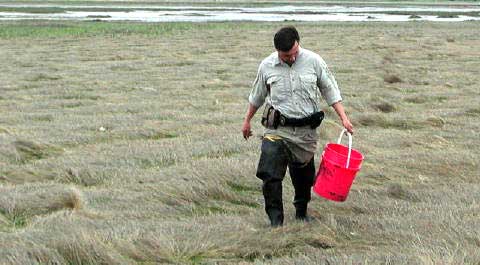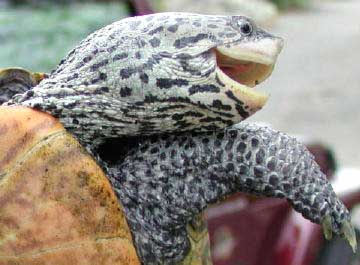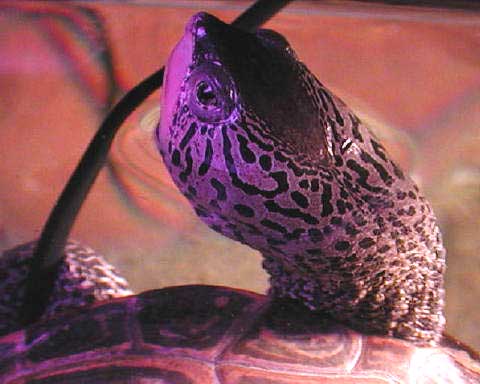“ . . . With a Little Help from My Friends” — 7 May 2002
Who’d a-thunk it? An overcast blustery day with little prospects for turtling and consequently filled with the detailed and mundane chores of life. Yet, with a help of observant friends, we still managed two exciting discoveries.
The first came around 2:00 p.m. when a neighbor called. She lives about three-fourths of a mile to the east with her cottage backing on a fresh water bog. Last spring I discovered a spotted turtle, fairly rare on the Outer Cape, strolling across the street in front of her home. So, a few days ago I asked her to be especially watchful for critters emerging from the bog perhaps to nest in her yard.
That conversation proved prophetic. Sue phoned to say she had discovered a tiny turtle strolling down her driveway right in front of her garage.

Well, it wasn’t a spotted turtle, but it was a perfect painted turtle hatchling. It sported no egg tooth, but did exhibit a rather brash and aggressive attitude. The yolk sac was completely absorbed with only the faintest trace remaining on its plastron.
  As I drove back to Connemara Cottage with the hatchling, Wellfleet’s shellfish constable pulled up in front of the house. A PhD-candidate biologist, Bill Walton has been a good friend and colleague. As he strolled through knee-deep muck in Loagy Bay to chat with a working shellfisherman, he encountered a diamondback terrapin buried in mud with the top of its carapace protruding.
As I drove back to Connemara Cottage with the hatchling, Wellfleet’s shellfish constable pulled up in front of the house. A PhD-candidate biologist, Bill Walton has been a good friend and colleague. As he strolled through knee-deep muck in Loagy Bay to chat with a working shellfisherman, he encountered a diamondback terrapin buried in mud with the top of its carapace protruding.
  What a find this turtle proved to be! Terrapin 71 was first marked back in 1988 as she nested on nearby Lieutenant Island. She was 11 years old, measured 16.1 centimeters carapace length, 15.2 plastron, and weighed 765 grams. She disappeared for the next eight years, only to be found nesting in the same area in 1996. By then she measured 17.6 & 15.5 centimeters and weighed 932 grams.
What a find this turtle proved to be! Terrapin 71 was first marked back in 1988 as she nested on nearby Lieutenant Island. She was 11 years old, measured 16.1 centimeters carapace length, 15.2 plastron, and weighed 765 grams. She disappeared for the next eight years, only to be found nesting in the same area in 1996. By then she measured 17.6 & 15.5 centimeters and weighed 932 grams.
So, it is no surprise that she had a lot to tell us today. This was the first chance we had to see her in a non-nesting mode, probably just emerging from brumation based on the layers of mud caked inside her shell cavities. In the intervening six years since 1996, Terrapin 71 has reached 18.3 centimeters carapace length, 16.1 centimeters plastron, and 1175 grams weight.
  Because she’s such an animated conversationalist, I asked #77 to spend the night. Tomorrow a group of Vermont students will visit the Land of Ooze to learn about diamondback terrapin research and conservation. And there’s no question, she has a lot to say on this topic of vital importance . . . especially to her.
Because she’s such an animated conversationalist, I asked #77 to spend the night. Tomorrow a group of Vermont students will visit the Land of Ooze to learn about diamondback terrapin research and conservation. And there’s no question, she has a lot to say on this topic of vital importance . . . especially to her.
|